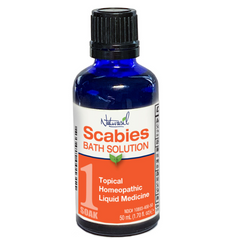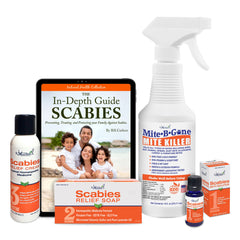Sarcoptes scabiei, a tiny mite, is the cause of the common and frequently misunderstood skin condition known as scabies. These microscopic parasites burrow into the upper layer of the skin, leading to intense itching and characteristic rashes. Understanding scabies' causes, symptoms, and diagnostic methods is vital for timely intervention and effective management.
What causes scabies?
As mentioned, the causative agent of scabies is the microscopic mite known as Sarcoptes scabiei. A brief insight into its life cycle and interaction with human skin illuminates the foundation of this condition.
- Lifecycle and Burrowing: The female Sarcoptes scabiei mite is responsible for the hallmark manifestations of scabies. Once she finds a suitable spot on human skin, she burrows deep, creating tunnels where she deposits her eggs. As these eggs hatch and larvae grow, they migrate onto the skin surface, intensifying the infestation.
- The Allergic Cascade: It's not just the mite's physical presence that causes distress. The human body identifies the mite, its eggs, and especially its fecal matter as foreign invaders. This leads the immune system to launch an allergic response. Histamines and other inflammatory mediators are released, causing intense itching and the characteristic rash associated with scabies.
Transmission Dynamics of Scabies
Understanding how scabies spreads is vital to its prevention and control.
- Direct Transmission: Direct skin-to-skin contact remains the most efficient way for scabies mites to transfer from one host to another. Such close personal interactions, familial or intimate, can provide the mites with the warmth and environment they crave.
- Indirect Transmission: While mites have a limited lifespan away from the human body, they can still survive for some days under the right conditions. Thus, items that come in direct contact with infested skin, such as bedding, clothing, or towels, can harbor these mites. When another person uses these items, there's a risk, albeit lower, of getting infested.
Clinical Presentation of Scabies
The physical manifestations of scabies are distressing, but recognizing them early can lead to timely intervention.
- The Itch Factor: Among the myriad of symptoms, the intense, relentless itching stands out, often becoming more pronounced at night. This nocturnal exacerbation can be attributed to the body's temperature changes and increased mite activity.
- Rash Revelations: Scabies rash is not just any rash. It manifests as tiny red or pinkish bumps, often arranged linearly due to the mite's burrowing path. Prime locations for these rashes are interdigital spaces (webs of fingers), wrists, elbows, knees, buttocks, and waist. The genital region is also frequently affected, given its warmth and moisture.
- Tales of the Burrows: One of the pathognomonic signs of scabies is the presence of burrow lines. These are the tunnels that the female mites make as they lay their eggs. These burrows manifest as thin, irregular, slightly raised silvery lines on the skin, with a mite occasionally visible at one end. The presence of these lines can greatly aid in the diagnosis.
Scabies in Different Populations
Scabies in Children and Infants
Scabies, a condition primarily known for its distinctive rash and relentless itch, manifests differently across age groups. In the delicate skin of children and infants, the symptoms of scabies can be particularly distressing. Unlike adults, where the rash typically appears in specific regions like between fingers or on the wrists, children and infants are more prone to having these rashes in more expansive areas.
The head, face, and neck are not typically affected in adults but are common sites in younger populations. Furthermore, infants' tender palms and soles might also exhibit signs of the mite's burrows or their reddish-brown rash. The reason behind this variance is twofold: the skin of children and infants is softer, making it easier for the mite to burrow, and their immune responses to the mites are still developing, leading to different inflammation patterns. Parents and caregivers must be particularly vigilant about such manifestations in children, given their propensity to scratch, which can lead to secondary bacterial infections.
Scabies in Elderly Adults and Immunocompromised
As we turn our attention to the other end of the age spectrum, we find older adults grappling with a different set of challenges regarding scabies. Due to age and often accompanying health conditions, their skin might not exhibit the standard symptoms of scabies. Instead, they might experience what is medically termed crusted or Norwegian scabies. This form is not just a variant; it's an intensified version of the illness.
Crusted scabies are characterized by thick, crusty skin patches that can sometimes cover expansive body areas. These patches harbor large numbers of mites, making the condition highly contagious. The compromised immune system in older adults, or those with conditions that weaken their immune response, struggles to combat the mite infestation effectively, leading to this severe form.
Apart from the elders, individuals with diseases such as HIV/AIDS and Leukemia or those on medications like corticosteroids that suppress the immune system are also at risk. These populations have higher stakes, necessitating immediate medical attention and often a more aggressive treatment approach.
Accurate Diagnosis: The First Line of Defense
Scabies, a condition that emerges from microscopic mite infestations, requires a meticulous approach to diagnosis. Being such a contagious ailment, its prompt and accurate identification is paramount to ensuring effective treatment.
Initially, a visual examination is undertaken. Here, a healthcare professional is looking for the telltale signs—the burrow tracks and the characteristic rash. However, given the variability in presentation, especially among different populations, this may only sometimes suffice.
A skin scraping test might be used to confirm the diagnosis. In this procedure, a dermatologist obtains a small sample from the affected skin area, which is then meticulously examined under a microscope. The discovery of mites, their eggs, or their fecal matter indicates a scabies infestation.
In contemporary dermatology, tools like dermoscopy are also leveraged. Offering a magnified view of the skin, it aids professionals in spotting the elusive mites or their burrows, streamlining the diagnostic process.
Stemming the Spread: Proactive Prevention
Equally vital to the diagnosis is ensuring the containment of scabies. Its highly contagious nature necessitates proactive measures to curtail its spread.
First and foremost, immediate treatment is essential. Upon diagnosis, individuals should expedite their therapeutic regime. Delays not only aggravate personal discomfort but also increase the risk of transmission.
Simultaneously, a rigorous household cleaning protocol should be activated. Any bedding, clothing, or towels that might have come into contact with the affected individual should undergo a thorough cleaning—washed in hot water and dried on high heat. This ensures the elimination of any mites that may have ventured away from their human host.
Lastly, isolation plays a pivotal role. Direct skin-to-skin interactions should be minimized until the treatment is completed and a clean bill of health is given.
From Recognition to Resolution
Scabies presents as more than a transient discomfort; it evolves into a profoundly unsettling experience for many. Its insidious nature demands vigilance in its early detection, precision in diagnosis, and an unwavering commitment to comprehensive treatment. Delving into its origin, discerning its symptoms, and mastering the methods of diagnosis equips one to counteract its impacts expeditiously. For those seeking optimal solutions, exploring treatment for scabies offers a well-curated range of therapeutic interventions. By aligning with trusted resources such as scabies treatment, not only can one attain relief from its vexing symptoms but also ensure the halting of its transmission, safeguarding both oneself and the broader community.








